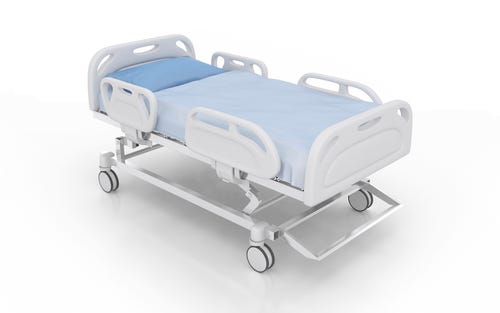3 Must-Have Features for Mobile Medical Devices
February 16, 2017
Are your devices tough enough?

There's a trend toward mobile medical equipment today, observes Josh Blackmore, Global Healthcare Manager at RTP Company. "People are bringing medical technology to the patient," he told Qmed at MD&M West. "Why move a sick patient?"
Mobile equipment for ultrasound and x-ray procedures is being developed, as are mobile pharmacies and other devices, Blackmore noted. "There's definitely a trend toward putting equipment on wheels," he added. Such equipment can be developed for hospitals and outpatient clinics as well as for home use. At the show, RTP Company highlighted its thermoplastic compounds that can be used for mobile medical equipment.
For mobility, medical equipment must satisfy three important needs: it must be able to withstand disinfectants, it must be tough and durable with lasting aesthetics, and it must be light weight.
To be able to offer such features, the materials used for such equipment must be chemically resistant and structurally strong, says Blackmore. "Materials must withstand being cleaned with high frequency," he says.
Materials also must be tough so that "when equipment is banged into a wall--which happens with mobile devices--the number of scuff and stress marks are minimized," he adds.
Finally, materials must be light weight to facilitate device portability, without sacrificing strength, Blackmore says. Hospital beds, wheel chairs, and other patient-transport devices, too, can benefit from lighter-weight, high-strength plastics that are able to replace metals. "In hospitals today, the idea is to have just one person move a patient," he adds.
At MD&M West, RTP Company highlighted its polypropylene and nylon compounds that can help manufacturers develop mobile medical equipment that meet such needs. One material in particular, RTP 107 XP, a glass-filled polypropylene, offers rigidity, strength, and dimensional stability along with good heat and chemical resistance. "It features glass fiber technology that approaches the strength of long glass fiber technology, yet it is priced comparably to low-cost glass-filled polypropylene," says Blackmore.
RTP Company's polypropylene (PP) 100 series as well as its nylon (PA) 200 series offer grades resistant to high-, intermediate-, and low-level disinfectants. The compounds are RoHS compliant; flame-retardant grades are also available to meet RoHS directive 2011/65/EC.
The compounds can also be blended with custom colors to eliminate the need for paint and with UV stabilizers to withstand light.
For more details, visit RTP Company at Booth #2003 at MD&M East in New York City June 13-15.
Daphne Allen is executive editor of Pharmaceutical & Medical Packaging News and a contributor to Qmed. Reach her at [email protected] and on Twitter at @daphneallen
[image courtesy of RTP COMPANY]
About the Author(s)
You May Also Like



.png?width=300&auto=webp&quality=80&disable=upscale)
